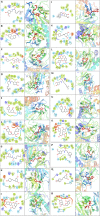In silico profiling of nonsynonymous SNPs of fat mass and obesity-associated gene: possible impacts on the treatment of non-alcoholic fatty liver disease
- PMID: 36717943
- PMCID: PMC9885621
- DOI: 10.1186/s12944-023-01782-7
In silico profiling of nonsynonymous SNPs of fat mass and obesity-associated gene: possible impacts on the treatment of non-alcoholic fatty liver disease
Abstract
Background: Nonalcoholic fatty liver, or NAFLD, is the most common chronic liver ailment. It is characterized by excessive fat deposition in hepatocytes of individuals who consume little or no alcohol and are unaffected by specific liver damaging factors. It is also associated with extrahepatic manifestations such as chronic kidney disease, cardiovascular disease, and sleep apnea. The global burden of NAFLD is increasing at an alarming rate. However, no pharmacologically approved drugs against NAFLD are available owing to their complex pathophysiology. Genome-wide association studies have uncovered SNPs in the fat mass and obesity-associated gene (FTO) that are robustly associated with obesity and higher BMI. The prevalence of NAFLD increases in parallel with the increasing prevalence of obesity. Since FTO might play a crucial role in NAFLD development, the current study identified five potentially deleterious mutations from 383 ns-SNPs in the human FTO gene using various in silico tools.
Methods: This study aims to identify potentially deleterious nonsynonymous SNPs (ns-SNPs) employing various in silico tools. Additionally, molecular modeling approaches further studied the structural changes caused by identified SNPs. Moreover, molecular dynamics studies finally investigated the binding potentials of the phytochemicals resveratrol, rosmarinic acid, and capsaicin with different mutant forms of FTO.
Results: The current investigation has five potentially deleterious mutations from 383 ns-SNPs in the human FTO gene using various in silico tools. The present study identified five nsSNPs of the human gene FTO, Gly103Asp, Arg96Pro, Tyr295Cys, and Arg322Gln, with an apparent connection to the disease condition. Modulation of demethylation activity by phytomolecule scanning explains the hepatoprotective action of molecules. The current investigation also suggested that predicted mutations did not affect the binding ability of three polyphenols: rosamarinic acid, resveratrol, and capsaicin.
Conclusion: This study showed that the predicted mutations in FTO did not affect the binding of three polyphenols. Thus, these three molecules can significantly aid drug development against FTO and NAFLD.
Keywords: FTO ns-SNPs; Fat mass and obesity-associated gene (FTO); Genetic polymorphism; Lipogenesis; Nonalcoholic fatty liver disease (NAFLD); Nonalcoholic steatohepatitis (NASH).
© 2023. The Author(s).
Conflict of interest statement
The authors declare no competing interests.
Figures






Similar articles
-
Fat mass and obesity-associated protein promotes liver steatosis by targeting PPARα.Lipids Health Dis. 2022 Mar 13;21(1):29. doi: 10.1186/s12944-022-01640-y. Lipids Health Dis. 2022. PMID: 35282837 Free PMC article.
-
Unique genetic variants of lean nonalcoholic fatty liver disease: a retrospective cohort study.BMC Endocr Disord. 2023 Jan 10;23(1):11. doi: 10.1186/s12902-022-01234-w. BMC Endocr Disord. 2023. PMID: 36627697 Free PMC article.
-
Genome-wide association meta-analysis identifies 17 loci associated with nonalcoholic fatty liver disease.Nat Genet. 2023 Oct;55(10):1640-1650. doi: 10.1038/s41588-023-01497-6. Epub 2023 Sep 14. Nat Genet. 2023. PMID: 37709864 Free PMC article.
-
Fat Mass and Obesity Associated (FTO) Gene and Hepatic Glucose and Lipid Metabolism.Nutrients. 2018 Nov 1;10(11):1600. doi: 10.3390/nu10111600. Nutrients. 2018. PMID: 30388740 Free PMC article. Review.
-
The composite alliance of FTO locus with obesity-related genetic variants.Clin Exp Pharmacol Physiol. 2021 Jul;48(7):954-965. doi: 10.1111/1440-1681.13498. Epub 2021 Apr 8. Clin Exp Pharmacol Physiol. 2021. PMID: 33735452 Review.
References
-
- Hardy T, Oakley F, Anstee QM, Day CP. Non-alcoholic fatty liver disease: pathogenesis and disease spectrum. Annu Rev Pathol: Mech Dis. 2016;11:451–496. - PubMed
-
- Eslam M, George J. Genetic contributions to NAFLD: leveraging shared genetics to uncover systems biology. Nat Rev Gastroenterol Hepatol. 2020;17(1):40–52. - PubMed
MeSH terms
Substances
LinkOut - more resources
Full Text Sources
Medical
Miscellaneous

